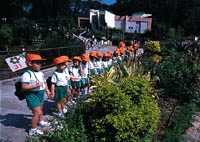|
The Environment
Hong Kong's environment - particularly air quality - was the subject of considerable
debate over the past year.
Much effort is being made to address the problems which are mainly a result of Hong
Kong's high urban population density - the highest in the world.
Hong Kong has twice the population of Los Angeles, in less than half the space. The
average urban population density in Hong Kong is 27 000 people per square kilometre
but it is as high as 50 000 people in some older districts. This compares with an
average of less than 9 000 in New York, about 6 000 in San Francisco, 5 500 in Toronto
and 2 900 in Los Angeles.
So many people moving around in such a small area requires a tremendous amount of
transport movement, even if most is public transport.
In some districts, Hong Kong does have a street-level air pollution problem caused
by a number of factors, which includes a convergence of major roadways and a concentration
of high-rise buildings which makes it difficult for air to circulate.
In overall terms of ambient air quality, Hong Kong has not been doing too badly.
Since 1993 nitrogen oxides and sulphur dioxide emissions have been reduced by more
than 30% and, on a per capita basis, are significantly lower than levels in the US
and Canada. Carbon dioxide levels in 2000 will be similar to the 1990 level.
In 1998, there was one day in which Hong Kong's ambient air quality exceeded 100
on the air pollution index (which matches the US's PSI) - the same as Seattle in
1997 and considerably better than the 66 days in Los Angeles and 24 in New York.
Diesel emissions are the major cause of Hong Kong's air quality problems, but pollution
'spillover' from adjoining Guangdong Province, which is more heavily industrialised,
is also a factor.
Hong Kong is addressing these issues in a number of ways:
- Expanding the energy-efficient railway system by 40% by 2004, with the aim to
increase its share of total public transport patronage from the current level of
30% to 45%.
- Converting Hong Kong's 18 000 diesel taxis to LPG from end-2000 to 2005
- Spending HK$8 billion (US$1.02 billion) on a major sewage treatment scheme which
will significantly reduce water pollution
- Working closely with authorities in Guangdong Province to develop pollution control
programmes
- A Waste Reduction Framework Plan to reduce by almost 60% the amount of municipal
waste sent to landfills by 2007
- Planting more than 500 000 trees each year in urban areas and country parks
 |
Last updated: June 1999 |
|


|

